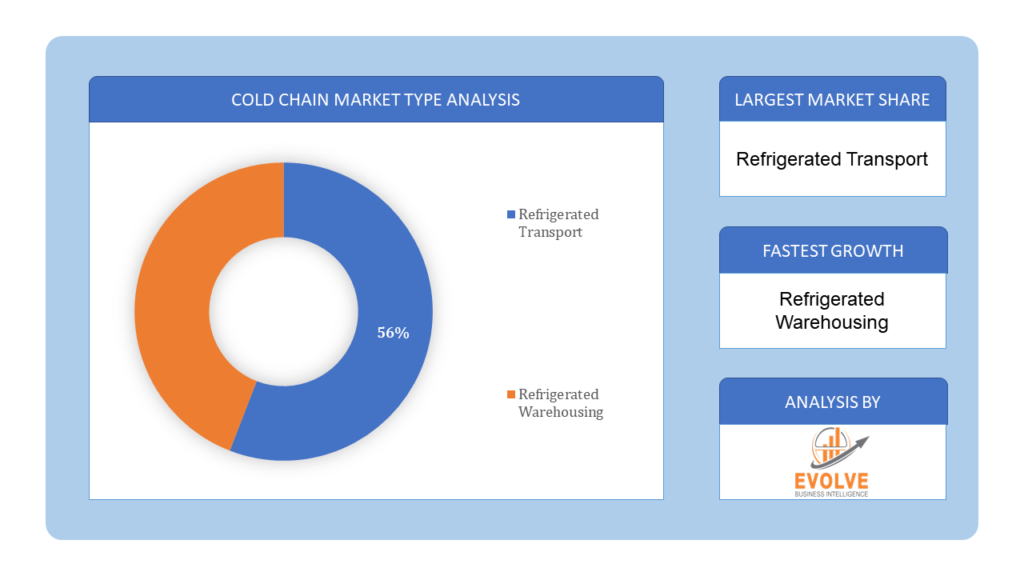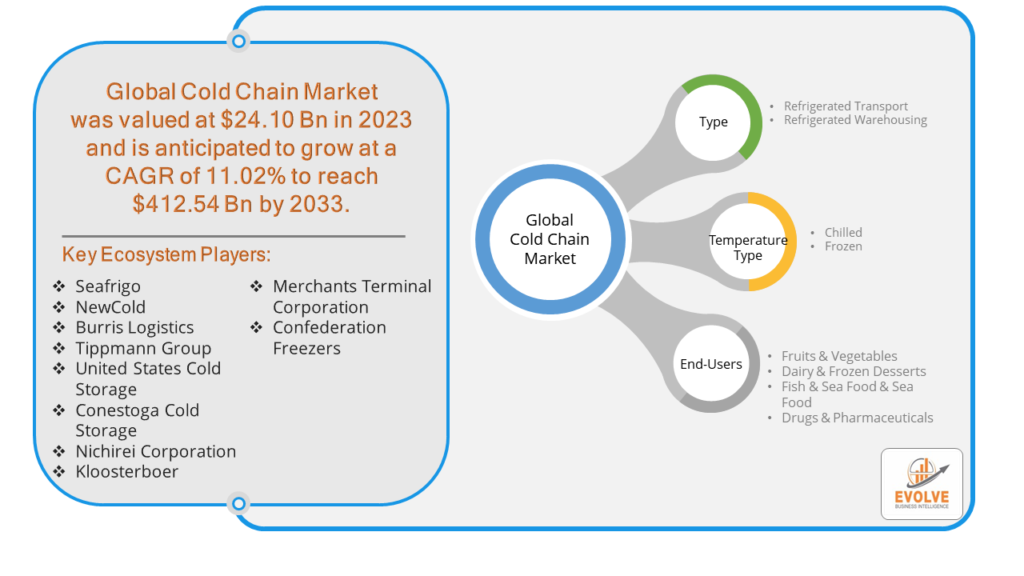Cold Chain Market Analysis and Global Forecast 2023-2033
$ 1,390.00 – $ 5,520.00Price range: $ 1,390.00 through $ 5,520.00
Cold Chain Market Research Report: By End-Users Industry (Fruits & Vegetables, Dairy & Frozen Desserts, Fish & Sea Food & Sea Food, Drugs & Pharmaceuticals), By Temperature Type (Frozen, Chilled), By Type (Refrigerated Transport, Refrigerated Warehousing), and by Region — Forecast till 2033
Page: 162
Cold Chain Market Overview
The Cold Chain Market Size is expected to reach USD 412.54 Billion by 2033. The Cold Chain industry size accounted for USD 24.10 Billion in 2023 and is expected to expand at a compound annual growth rate (CAGR) of 11.02% from 2023 to 2033. The cold chain market refers to the infrastructure and processes required to maintain the integrity and quality of temperature-sensitive products throughout the supply chain. This includes refrigeration, transportation, and storage solutions to preserve items like food, pharmaceuticals, and chemicals. It ensures that these goods remain within specified temperature ranges from production to consumption, preventing spoilage, contamination, and ensuring safety and efficacy. The market is driven by increasing demand for perishable goods globally, stringent regulations, and advancements in refrigeration technology.
Global Cold Chain Market Synopsis
The Cold Chain market experienced a positive impact due to the COVID-19 pandemic. Due to supply chain interruptions brought on by the COVID-19 pandemic, there are now shortages or decreased demand in the cold chain sector. Spending by consumers and businesses has decreased significantly as a result of the travel restrictions and social distancing measures, and this trend is expected to persist for some time. The epidemic has altered end-user trends and tastes, prompting manufacturers, developers, and service providers to implement diverse tactics aimed at stabilizing their businesses.
Global Cold Chain Market Dynamics
The major factors that have impacted the growth of Cold Chain are as follows:
Drivers:
⮚ Technological Advancements
Continuous advancements in refrigeration technology, cold storage facilities, and temperature monitoring systems have improved the efficiency, reliability, and sustainability of cold chain logistics. Innovations such as remote temperature monitoring, IoT-enabled sensors, and blockchain-based traceability solutions enhance transparency, reduce wastage, and optimize resource utilization within the cold chain.
Restraint:
- High Initial Investment and Operational Costs
Establishing and maintaining a cold chain infrastructure involves substantial initial investments in refrigeration equipment, cold storage facilities, transportation vehicles, and temperature monitoring systems.Additionally, the operational costs associated with energy consumption, maintenance, and skilled labor can be significant, posing a barrier to entry for small and medium-sized enterprises (SMEs) and businesses in developing regions.
Opportunity:
⮚ Rise of E-commerce and Direct-to-Consumer Delivery
The growth of e-commerce platforms and changing consumer behavior have accelerated the demand for online grocery shopping and direct-to-consumer delivery of perishable goods. Cold chain logistics companies can capitalize on this trend by offering last-mile delivery solutions, temperature-controlled packaging, and real-time tracking capabilities to ensure the freshness and safety of products during transit.
Cold Chain Market Segment Overview
By End-Users Industry
Based on the End-Users Industry, the market is segmented based on Fruits & Vegetables, Dairy & Frozen Desserts, Fish & Sea Food & Sea Food, Drugs & Pharmaceuticals. These segments represent key sectors relying on cold chain logistics for preserving freshness, quality, and safety of perishable goods, ensuring they reach consumers in optimal condition.
By Temperature Type
Based on the Temperature Type, the market has been divided into Frozen, Chilled. Frozen refers to products stored and transported at temperatures below freezing point, typically for long-term preservation. Chilled involves maintaining products at temperatures slightly above freezing, preserving freshness without freezing, and catering to shorter storage and transportation durations.
By Type
 Based on Type, the market has been divided into Refrigerated Transport, Refrigerated Warehousing In the cold chain market segmented by type, Refrigerated Transport and Refrigerated Warehousing are dominant segments. Refrigerated Transport encompasses vehicles and containers equipped with refrigeration systems for the transportation of perishable goods.
Based on Type, the market has been divided into Refrigerated Transport, Refrigerated Warehousing In the cold chain market segmented by type, Refrigerated Transport and Refrigerated Warehousing are dominant segments. Refrigerated Transport encompasses vehicles and containers equipped with refrigeration systems for the transportation of perishable goods.
Global Cold Chain Market Regional Analysis
Based on region, the market has been divided into North America, Europe, Asia-Pacific, the Middle East & Africa, and Latin America. The area of North America is anticipated to dominate the market for the usage of Cold Chain, followed by those in Asia-Pacific and Europe.
Cold Chain North America Market
North America dominates the Cold Chain market due to several factors. In North America, the cold chain market is robust and well-established, driven by stringent regulatory standards, technological advancements, and a mature logistics infrastructure. The region’s growing demand for perishable goods, including fresh produce, dairy products, seafood, and pharmaceuticals, fuels the expansion of cold chain services. Major players in the industry leverage advanced refrigeration technologies, temperature monitoring systems, and efficient transportation networks to ensure the integrity and safety of temperature-sensitive products throughout the supply chain.
Cold Chain Asia Pacific Market
The Asia-Pacific region has been witnessing remarkable growth in recent years. In Asia Pacific, the cold chain market is experiencing rapid growth driven by urbanization, rising disposable incomes, and changing consumption patterns. The region’s expanding population and increasing demand for fresh food, pharmaceuticals, and other temperature-sensitive products are key drivers. Investments in cold chain infrastructure, including refrigerated storage facilities, transportation networks, and technology solutions, are on the rise to meet the growing demand and address logistical challenges. Government initiatives aimed at improving food safety standards and reducing post-harvest losses further contribute to market expansion in Asia Pacific.
Competitive Landscape
The competitive landscape includes key players (tier 1, tier 2, and local) having a presence across the globe. Companies such as Seafrigo, NewCold, BURRIS LOGISTICS, Tippmann Group, and United States Cold Storage are some of the leading players in the global Cold Chain Industry. These players have adopted partnership, acquisition, expansion, and new product development, among others as their key strategies.
Key Market Players:
- Seafrigo
- NewCold
- BURRIS LOGISTICS
- Tippmann Group
- United States Cold Storage
- Conestoga Cold Storage
- Nichirei Corporation
- Kloosterboer
- Merchants Terminal Corporation
- Confederation Freezers
Key development:
In September 2022, Burris Logistics expanded its cold chain capabilities by investing in state-of-the-art refrigerated storage facilities and implementing advanced technology solutions to enhance temperature control and traceability throughout its supply chain.
Scope of the Report
Global Cold Chain Market, by End-Users Industry
- Fruits & Vegetables
- Dairy & Frozen Desserts
- Fish & Sea Food & Sea Food
- Drugs & Pharmaceuticals
Global Cold Chain Market, by Temperature Type
- Frozen
- Chilled
Global Cold Chain Market, by Type
- Refrigerated Transport
- Refrigerated Warehousing
Global Cold Chain Market, by Region
- North America
- US
- Canada
- Mexico
- Europe
- UK
- Germany
- France
- Italy
- Spain
- Benelux
- Nordic
- Rest of Europe
- Asia Pacific
- China
- Japan
- South Korea
- Indonesia
- Austalia
- Malaysia
- India
- Rest of Asia Pacific
- South America
- Brazil
- Argentina
- Rest of South America
- Middle East & Africa
- Saudi Arabia
- UAE
- Egypt
- South Africa
- Rest of Middle East & Africa
| Parameters | Indicators |
|---|---|
| Market Size | 2033: $412.54 Billion |
| CAGR | 11.02% CAGR (2023-2033) |
| Base year | 2022 |
| Forecast Period | 2023-2033 |
| Historical Data | 2021 |
| Report Coverage | Revenue Forecast, Competitive Landscape, Growth Factors, and Trends |
| Key Segmentations | End-Users Industry, Temperature Type, Type |
| Geographies Covered | North America, Europe, Asia-Pacific, Latin America, Middle East, Africa |
| Key Vendors | Seafrigo, NewCold, BURRIS LOGISTICS, Tippmann Group, United States Cold Storage, Conestoga Cold Storage, Nichirei Corporation, Kloosterboer, Merchants Terminal Corporation, Confederation Freezers. |
| Key Market Opportunities | • Creative Content Generation and Personalization |
| Key Market Drivers | • Advancements in AI research and technology • Growing demand for personalized and creative content |
REPORT CONTENT BRIEF:
- High-level analysis of the current and future Cold Chain Industry trends and opportunities
- Detailed analysis of current market drivers, restraining factors, and opportunities analysis in the future
- Historical market size for the year 2021, and forecast from 2023 to 2033
- Cold Chain market share analysis for each segment
- Competitor analysis with a comprehensive insight into its product segment, financial strength, and strategies adopted.
- Identifies key strategies adopted by the key players including new product development, mergers and acquisitions, joint ventures, collaborations, and partnerships.
- To identify and understand the various factors involved in the global Cold Chain market affected by the pandemic
- To provide year-on-year growth from 2022 to 2033
- To provide short-term, long-term, and overall CAGR comparison from 2022 to 2033.
- Provide Total Addressable Market (TAM) for the Global Cold Chain Market.
Press Release

Global Pharmaceutical Manufacturing Market to Reach $1.38 Trillion by 2035 with 7.35% CAGR, New Research Shows

The Global Mammography Market Is Estimated To Record a CAGR of Around 10.29% During The Forecast Period

Glue Stick Market to Reach USD 2.35 Billion by 2034

Podiatry Service Market to Reach USD 11.88 Billion by 2034

Microfluidics Technology Market to Reach USD 32.58 Billion by 2034

Ferric Chloride Market to Reach USD 10.65 Billion by 2034

Family Practice EMR Software Market to Reach USD 21.52 Billion by 2034

Electric Hairbrush Market to Reach USD 15.95 Billion by 2034

Daily Bamboo Products Market to Reach USD 143.52 Billion by 2034

Cross-border E-commerce Logistics Market to Reach USD 112.65 Billion by 2034
Frequently Asked Questions (FAQ)
What is the study period of the Cold Chain Market?
The study period for the Cold Chain Market spans from 2023 to 2033.
What is the growth rate of the Cold Chain Market?
The Cold Chain Market is expected to grow at a compound annual growth rate (CAGR) of 11.02% from 2023 to 2033.
Which region has the highest growth rate in the Cold Chain Market?
The Asia-Pacific region has the highest growth rate in the Cold Chain Market.
Which region has the largest share of the Cold Chain Market?
North America holds the largest share of the Cold Chain Market.
Who are the key players in the Cold Chain Market?
Key players in the Cold Chain Market include Seafrigo, NewCold, BURRIS LOGISTICS, Tippmann Group, and United States Cold Storage.
Do you offer Post sales support?
Yes, we offer 16 hours of analyst support to solve the queries
Do you sell particular sections of a report?
Yes, we provide regional as well as country-level reports. Other than this we also provide a sectional report. Please get in contact with our sales representatives.
Table of Content
CHAPTER 1. Executive Summary CHAPTER 2. Scope of the Study 2.1. Market Definition 2.2. Market Scope & Segmentation 2.2.1. Objective of Report CHAPTER 3. Evolve BI Methodology 3.1. Data Collection & Validation Approach 3.2. Market Size Estimation and Forecast CHAPTER 4. Exclusive Analysis 4.1. Market Opportunity Score 4.1.1. End-Users Industry Segement – Market Opportunity Score 4.1.2. Temperature Type Segment – Market Opportunity Score 4.1.3. Type Segment – Market Opportunity Score 4.2. Key Market Influencing Indicators CHAPTER 5. Market Insights and Trends 5.1. Value Chain Analysis 5.1.1. Raw Material 5.1.2. Manufacturing Process 5.1.3. Distribution Channel 5.1.4. End User 5.2. Porter’s Five Forces Analysis 5.2.1. Bargaining Power of Buyers 5.2.2. Bargaining Power of Suppliers 5.2.3. Threat of New Entrant 5.2.4. Threat of Substitute 5.2.5. Industry Rivalry 5.3. COVID-19 Impact and Post COVID Scenario on Cold Chain Market 5.3.1. Impact of COVID-19 5.3.2. Government Support and Industry Revival Policies 5.3.3. Measures Taken by Companies to Mitigate Negative Impact 5.3.4. Post COVID Trend CHAPTER 6. MArket Dynamics 6.1. Introduction 6.2. Drivers 6.2.1. Driver 1 6.2.2. Driver 2 6.2.3. Driver 3 6.3. Restraints 6.3.1. Restraint 1 6.3.2. Restraint 2 6.4. Opportunity 6.4.1. Opportunity 1 CHAPTER 7. Global Cold Chain Market, By End-Users Industry 7.1. Introduction 7.1.1. Fruits & Vegetables 7.1.2. Dairy & Frozen Desserts 7.1.3. Fish & Sea Food & Sea Food 7.1.4. Drugs & Pharmaceuticals CHAPTER 8. Global Cold Chain Market, By Temperature Type 8.1. Introduction 8.1.1. Frozen 8.1.2. Chilled CHAPTER 9. Global Cold Chain Market, By Type 9.1. Introduction 9.1.1. Refrigerated Transport 9.1.2. Refrigerated Warehousing CHAPTER 10. Global Cold Chain Market, By Region 10.1. Introduction 10.2. NORTH AMERICA 10.2.1. North America: Market Size and Forecast, By Country, 2023 – 2033 ($ Million) 10.2.2. North America: Market Size and Forecast, By End-Users Industry, 2023 – 2033 ($ Million) 10.2.3. North America: Market Size and Forecast, By Temperature Type, 2023 – 2033 ($ Million) 10.2.4. North America: Market Size and Forecast, By Type, 2023 – 2033 ($ Million) 10.2.5. US 10.2.5.1. US: Market Size and Forecast, By End-Users Industry, 2023 – 2033 ($ Million) 10.2.5.2. US: Market Size and Forecast, By Temperature Type, 2023 – 2033 ($ Million) 10.2.5.3. US: Market Size and Forecast, By Type, 2023 – 2033 ($ Million) 10.2.6. CANADA 10.2.6.1. Canada: Market Size and Forecast, By End-Users Industry, 2023 – 2033 ($ Million) 10.2.6.2. Canada: Market Size and Forecast, By Temperature Type, 2023 – 2033 ($ Million) 10.2.6.3. Canada: Market Size and Forecast, By Type, 2023 – 2033 ($ Million) 10.2.7. MEXICO 10.2.7.1. Mexico: Market Size and Forecast, By End-Users Industry, 2023 – 2033 ($ Million) 10.2.7.2. Mexico: Market Size and Forecast, By Temperature Type, 2023 – 2033 ($ Million) 10.2.7.3. Mexico: Market Size and Forecast, By Type, 2023 – 2033 ($ Million) 10.3. Europe 10.3.1. Europe: Market Size and Forecast, By Country, 2023 – 2033 ($ Million) 10.3.2. Europe: Market Size and Forecast, By End-Users Industry, 2023 – 2033 ($ Million) 10.3.3. Europe: Market Size and Forecast, By Temperature Type, 2023 – 2033 ($ Million) 10.3.4. Europe: Market Size and Forecast, By Type, 2023 – 2033 ($ Million) 10.3.5. U.K. 10.3.5.1. U.K.: Market Size and Forecast, By End-Users Industry, 2023 – 2033 ($ Million) 10.3.5.2. U.K.: Market Size and Forecast, By Temperature Type, 2023 – 2033 ($ Million) 10.3.5.3. U.K.: Market Size and Forecast, By Type, 2023 – 2033 ($ Million) 10.3.6. GERMANY 10.3.6.1. Germany: Market Size and Forecast, By End-Users Industry, 2023 – 2033 ($ Million) 10.3.6.2. Germany: Market Size and Forecast, By Temperature Type, 2023 – 2033 ($ Million) 10.3.6.3. Germany: Market Size and Forecast, By Type, 2023 – 2033 ($ Million) 10.3.7. FRANCE 10.3.7.1. France: Market Size and Forecast, By End-Users Industry, 2023 – 2033 ($ Million) 10.3.7.2. France: Market Size and Forecast, By Temperature Type, 2023 – 2033 ($ Million) 10.3.7.3. France: Market Size and Forecast, By Type, 2023 – 2033 ($ Million) 10.3.8. ITALY 10.3.8.1. Italy: Market Size and Forecast, By End-Users Industry, 2023 – 2033 ($ Million) 10.3.8.2. Italy: Market Size and Forecast, By Temperature Type, 2023 – 2033 ($ Million) 10.3.8.3. Italy: Market Size and Forecast, By Type, 2023 – 2033 ($ Million) 10.3.9. SPAIN 10.3.9.1. Spain: Market Size and Forecast, By End-Users Industry, 2023 – 2033 ($ Million) 10.3.9.2. Spain: Market Size and Forecast, By Temperature Type, 2023 – 2033 ($ Million) 10.3.9.3. Spain: Market Size and Forecast, By Type, 2023 – 2033 ($ Million) 10.3.10. BENELUX 10.3.10.1. BeNeLux: Market Size and Forecast, By End-Users Industry, 2023 – 2033 ($ Million) 10.3.10.2. BeNeLux: Market Size and Forecast, By Temperature Type, 2023 – 2033 ($ Million) 10.3.10.3. BeNeLux: Market Size and Forecast, By Type, 2023 – 2033 ($ Million) 10.3.11. RUSSIA 10.3.11.1. Russia: Market Size and Forecast, By End-Users Industry, 2023 – 2033 ($ Million) 10.3.11.2. Russia: Market Size and Forecast, By Temperature Type, 2023 – 2033 ($ Million) 10.3.11.3. Russia: Market Size and Forecast, By Type, 2023 – 2033 ($ Million) 10.3.12. REST OF EUROPE 10.3.12.1. Rest of Europe: Market Size and Forecast, By End-Users Industry, 2023 – 2033 ($ Million) 10.3.12.2. Rest of Europe: Market Size and Forecast, By Temperature Type, 2023 – 2033 ($ Million) 10.3.12.3. Rest of Europe: Market Size and Forecast, By Type, 2023 – 2033 ($ Million) 10.4. Asia Pacific 10.4.1. Asia Pacific: Market Size and Forecast, By Country, 2023 – 2033 ($ Million) 10.4.2. Asia Pacific: Market Size and Forecast, By End-Users Industry, 2023 – 2033 ($ Million) 10.4.3. Asia Pacific: Market Size and Forecast, By Temperature Type, 2023 – 2033 ($ Million) 10.4.4. Asia Pacific: Market Size and Forecast, By Type, 2023 – 2033 ($ Million) 10.4.5. CHINA 10.4.5.1. China: Market Size and Forecast, By End-Users Industry, 2023 – 2033 ($ Million) 10.4.5.2. China: Market Size and Forecast, By Temperature Type, 2023 – 2033 ($ Million) 10.4.5.3. China: Market Size and Forecast, By Type, 2023 – 2033 ($ Million) 10.4.6. JAPAN 10.4.6.1. Japan: Market Size and Forecast, By End-Users Industry, 2023 – 2033 ($ Million) 10.4.6.2. Japan: Market Size and Forecast, By Temperature Type, 2023 – 2033 ($ Million) 10.4.6.3. Japan: Market Size and Forecast, By Type, 2023 – 2033 ($ Million) 10.4.7. INDIA 10.4.7.1. India: Market Size and Forecast, By End-Users Industry, 2023 – 2033 ($ Million) 10.4.7.2. India: Market Size and Forecast, By Temperature Type, 2023 – 2033 ($ Million) 10.4.7.3. India: Market Size and Forecast, By Type, 2023 – 2033 ($ Million) 10.4.8. SOUTH KOREA 10.4.8.1. South Korea: Market Size and Forecast, By End-Users Industry, 2023 – 2033 ($ Million) 10.4.8.2. South Korea: Market Size and Forecast, By Temperature Type, 2023 – 2033 ($ Million) 10.4.8.3. South Korea: Market Size and Forecast, By Type, 2023 – 2033 ($ Million) 10.4.9. THAILAND 10.4.9.1. Thailand: Market Size and Forecast, By End-Users Industry, 2023 – 2033 ($ Million) 10.4.9.2. Thailand: Market Size and Forecast, By Temperature Type, 2023 – 2033 ($ Million) 10.4.9.3. Thailand: Market Size and Forecast, By Type, 2023 – 2033 ($ Million) 10.4.10. INDONESIA 10.4.10.1. Indonesia: Market Size and Forecast, By End-Users Industry, 2023 – 2033 ($ Million) 10.4.10.2. Indonesia: Market Size and Forecast, By Temperature Type, 2023 – 2033 ($ Million) 10.4.10.3. Indonesia: Market Size and Forecast, By Type, 2023 – 2033 ($ Million) 10.4.11. MALAYSIA 10.4.11.1. Malaysia: Market Size and Forecast, By End-Users Industry, 2023 – 2033 ($ Million) 10.4.11.2. Malaysia: Market Size and Forecast, By Temperature Type, 2023 – 2033 ($ Million) 10.4.11.3. Malaysia: Market Size and Forecast, By Type, 2023 – 2033 ($ Million) 10.4.12. AUSTRALIA 10.4.12.1. Australia: Market Size and Forecast, By End-Users Industry, 2023 – 2033 ($ Million) 10.4.12.2. Australia: Market Size and Forecast, By Temperature Type, 2023 – 2033 ($ Million) 10.4.12.3. Australia: Market Size and Forecast, By Type, 2023 – 2033 ($ Million) 10.4.13. REST FO ASIA PACIFIC 10.4.13.1. Rest fo Asia Pacific: Market Size and Forecast, By End-Users Industry, 2023 – 2033 ($ Million) 10.4.13.2. Rest fo Asia Pacific: Market Size and Forecast, By Temperature Type, 2023 – 2033 ($ Million) 10.4.13.3. Rest fo Asia Pacific: Market Size and Forecast, By Type, 2023 – 2033 ($ Million) 10.5. South America 10.5.1. South America: Market Size and Forecast, By Country, 2023 – 2033 ($ Million) 10.5.2. South America: Market Size and Forecast, By End-Users Industry, 2023 – 2033 ($ Million) 10.5.3. South America: Market Size and Forecast, By Temperature Type, 2023 – 2033 ($ Million) 10.5.4. South America: Market Size and Forecast, By Type, 2023 – 2033 ($ Million) 10.5.5. BRAZIL 10.5.5.1. Brazil: Market Size and Forecast, By End-Users Industry, 2023 – 2033 ($ Million) 10.5.5.2. Brazil: Market Size and Forecast, By Temperature Type, 2023 – 2033 ($ Million) 10.5.5.3. Brazil: Market Size and Forecast, By Type, 2023 – 2033 ($ Million) 10.5.6. ARGENTINA 10.5.6.1. Argentina: Market Size and Forecast, By End-Users Industry, 2023 – 2033 ($ Million) 10.5.6.2. Argentina: Market Size and Forecast, By Temperature Type, 2023 – 2033 ($ Million) 10.5.6.3. Argentina: Market Size and Forecast, By Type, 2023 – 2033 ($ Million) 10.5.7. REST OF SOUTH AMERICA 10.5.7.1. Rest of South America: Market Size and Forecast, By End-Users Industry, 2023 – 2033 ($ Million) 10.5.7.2. Rest of South America: Market Size and Forecast, By Temperature Type, 2023 – 2033 ($ Million) 10.5.7.3. Rest of South America: Market Size and Forecast, By Type, 2023 – 2033 ($ Million) 10.6. Middle East & Africa 10.6.1. Middle East & Africa: Market Size and Forecast, By Country, 2023 – 2033 ($ Million) 10.6.2. Middle East & Africa: Market Size and Forecast, By End-Users Industry, 2023 – 2033 ($ Million) 10.6.3. Middle East & Africa: Market Size and Forecast, By Temperature Type, 2023 – 2033 ($ Million) 10.6.4. Middle East & Africa: Market Size and Forecast, By Type, 2023 – 2033 ($ Million) 10.6.5. SAUDI ARABIA 10.6.5.1. Saudi Arabia: Market Size and Forecast, By End-Users Industry, 2023 – 2033 ($ Million) 10.6.5.2. Saudi Arabia: Market Size and Forecast, By Temperature Type, 2023 – 2033 ($ Million) 10.6.5.3. Saudi Arabia: Market Size and Forecast, By Type, 2023 – 2033 ($ Million) 10.6.6. UAE 10.6.6.1. UAE: Market Size and Forecast, By End-Users Industry, 2023 – 2033 ($ Million) 10.6.6.2. UAE: Market Size and Forecast, By Temperature Type, 2023 – 2033 ($ Million) 10.6.6.3. UAE: Market Size and Forecast, By Type, 2023 – 2033 ($ Million) 10.6.7. EGYPT 10.6.7.1. Egypt: Market Size and Forecast, By End-Users Industry, 2023 – 2033 ($ Million) 10.6.7.2. Egypt: Market Size and Forecast, By Temperature Type, 2023 – 2033 ($ Million) 10.6.7.3. Egypt: Market Size and Forecast, By Type, 2023 – 2033 ($ Million) 10.6.8. SOUTH AFRICA 10.6.8.1. South Africa: Market Size and Forecast, By End-Users Industry, 2023 – 2033 ($ Million) 10.6.8.2. South Africa: Market Size and Forecast, By Temperature Type, 2023 – 2033 ($ Million) 10.6.8.3. South Africa: Market Size and Forecast, By Type, 2023 – 2033 ($ Million) 10.6.9. REST OF MIDDLE EAST & AFRICA 10.6.9.1. Rest of Middle East & Africa: Market Size and Forecast, By End-Users Industry, 2023 – 2033 ($ Million) 10.6.9.2. Rest of Middle East & Africa: Market Size and Forecast, By Temperature Type, 2023 – 2033 ($ Million) 10.6.9.3. Rest of Middle East & Africa: Market Size and Forecast, By Type, 2023 – 2033 ($ Million) CHAPTER 12. Competitive Landscape 12.1. Competitior Benchmarking 2023 12.2. Market Share Analysis 12.3. Key Developments Analysis By Top 5 Companies 12.4. Market Share Acquisition Strategies: Analysis of Key Approaches Employed by Top Players CHAPTER 13. Company Profiles 13.1. Seafrigo 13.1.1. Business Overview 13.1.2. Financial Analysis 13.1.2.1. Business Segment Revenue, 2020, 2021, 2022, $ Million 13.1.2.2. Geographic Revenue Mix, 2022 (% Share) 13.1.3. Product Portfolio 13.1.4. Recent Development and Strategies Adopted 13.1.5. SWOT Analysis 13.2. NewCold 13.3. BURRIS LOGISTICS 13.4. Tippmann Group 13.5. United States Cold Storage 13.6. Conestoga Cold Storage 13.7. Nichirei Corporation 13.8. Kloosterboer 13.9. Merchants Terminal Corporation 13.10. Genie AI Ltd
Connect to Analyst
Research Methodology









